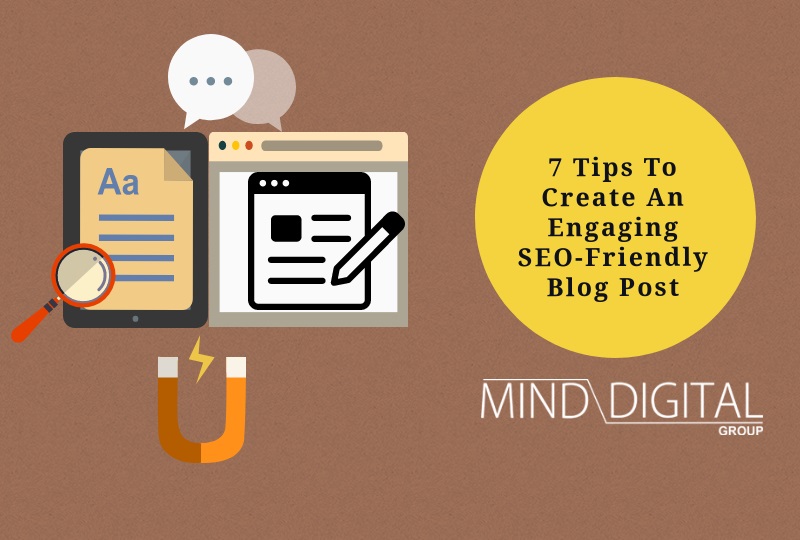
7 Tips To Create An Engaging SEO-Friendly Blog Post
Creative writing and SEO writing are completely different. When you want to publish a blog on a website, it requires you to fulfill some criteria. The blog post should be relevant to your website, and content should be keyword specific and SEO friendly. To make an SEO-friendly post, a writer should have an understanding of basic SEO.
When you create a post, keep the language simple and engaging to keep your reader interested. Informative, well-structured content is always practical to engage the reader. If the audience starts reading your blog, they will share it with their community, which will help your webpage to rank on the search engine result page (SERP).
If you want to create a valuable piece of content, improve your writing skills, enhance the power of research, and take basic knowledge of keywords and SEO optimization.
In this article, we will give you seven essential tips to make an engaging SEO-optimized blog post.
7 Tips to Craft SEO-Friendly Blog Post for your Website
Learn how to perform keyword research
Keyword research is the first and essential step to create SEO friendly article. If you do not implement an appropriate keyword in your article, it will just remain a creative piece. The search engine won’t promote via their crawling because the article won’t be SEO-friendly.
Before understanding the process of keyword research, you have to understand what a keyword is? Why it is so important.
The keyword is nothing but finding problems. The keyword is the queries that the audience puts in Google. The digital marketing team that works with SEO used to find out the queries or keywords with different keyword research tools. We find out the most effective keyword relevant to the blog topic and the search volume through keyword research. Here the search volume refers to how many people have the same problems or put the same queries in google to get the solution.
The basic keyword research process is to start with a free or paid keyword research tool and shortlist keywords through their search volume, conversion rate, and SEO difficulty. You get a bucket of relevant keywords to place them on your article for better ranking.
There are total of four types of keywords:
- Commercial: A commercial keyword is a query used for a paid advertising campaign. A commercial keyword is picked up depends on the niche of your Website
- Transactional: The transactional keyword is the search query for the target audience who have the objective to purchase a product or service very soon. The transactional keyword is the form demand of the product and inclined towards marketing. Transactional keywords show more targeted people who have the intention to buy a product or service or buy it soon.
- Informational: Informational keywords are awareness search queries. It usually has a high search volume. But it is not applicable for promotional purposes because it won’t bring the desirable conversion. It would be best if you placed Informational keywords in educational content. It is not suitable for promotional content that intends to generate sales.
- Navigational: The navigational keyword is used to identify or navigate a specific type of brand name, and it comes as a consequence of navigational search. When the audience already knows the brand name, and wants o know more about them, then they use search queries associated with the brand name. That is called the Navigational keyword.
Plan & structure your post
After doing an intense level of keyword research, you have to plan your blog content. If you want to create a good piece of writing, you have to do in-depth research about your topic. We would suggest you think before you write, read & research before you create. Your blog should be informational yet engaging, so find out more unique information about your topic from research papers, journals, and encyclopedias, enrich your piece with new information.
Lack of research makes your content monotonous and fluffy because repetitive information reduces the quality score of your content.
Apart from that, ask yourself few questions like what is the objective of your article? What message do you want to share? Who is your target audience? what does your target audience want from you?
These questions help you to create super-effective engaging content.
Create backbone of your content, then fill it with words
Don’t start writing after research. Make a backbone of content before it. When you write a blog post, make sure you are crafting a catchy headline before it. The audience actually attracted by catchy headlines. The headline should give an idea about the topic that you have discussed in the entire paragraph,
To create a readable and SEO-friendly article, you require to make a clear structure. Every post should have these basic things including:
- Introduction of your topic
- A body for the main message
- A conclusion where you have to put summarization of the whole idea of the topic with a positive tone
A basic structure of your content provides you a clear vision of your writing. In this way, your article will be compact yet impactful. To make your headline more impactful, place some keywords in the first two or three headlines like H1 and H2 tags. It will enhance your SEO score.
Use more paragraph
It is the right time to start writing your content. Use proper headlines and add content under them. We would suggest you don’t start a new sentence on a new line. It does not look nice. Don’t write your paragraph too lengthy because each paragraph comes with new information. Dedicate a unique idea for each paragraph; for this, you need a lot of research. However, doing high-level research makes your content engaging with no fluff.
Use transition words
Transition words such as “Hence”, “Therefore”, “accordingly”, “consequently”, “However” “additionally”, “besides”, “also”,” furthermore”, “moreover” are very helpful to make your content easily understand. It helps you to create a relationship between two lines and two paragraphs. For a cause-and-effect relationship, you should use “first of all,” “secondly,” and “finally.” To support a statement, use transition words like “For example,” “However,” “similarly’.
To summarize a statement, use “in short,” “to sum up.” Transition words are highly effective in increasing readability and SEO score.
Use related keywords
To get a high ranking on the search engine result page, you should not stuff your content with lots of focus keywords, and It will make your content less attractive and robotic. Even Google will not allow this because google algorithms keep changing with time. Stuffing your blog with a focus keyword can hurt your SEO score.
Instead of repetitively using focus keywords throughout the content, use LSI or related keywords to support your focus keyword.
Use synonym phrases and related keywords to strengthen your focus keyword and related statements.
Link your content
Link building is essential to make your post viral. If you make two or three posts about the same topic differently, link each other. It is called an inbound link.
SEO company India also suggests following outbound links. These linking procedures are showing the authority on a particular topic. Your link structure also affects your SEO Score. When you follow the interlinking procedure, the audience starts to move one content to another content. Through this way, they engage on the tour website and reduce the bounce rate. It is an effective procedure to increase the SEO score of your blog post.
Follow us
Recent post
Popular post
- How To Call Batch Apex By Scheduler Class Within Salesforce
- What Is The Importance Of Google Algorithm Updates
- How To Create Dynamic Dependent Picklist Of Objects Within Salesforce
- What Is Wrapper Class & How To Use It In Salesforce
- How To Create Pagination Within Salesforce
- Tips For Hiring A Good Offshore Drupal Development Company
- Web Development Mistakes That Affect Your Online Reputation
- How To Integrate Google Maps Into Your Salesforce Software
- Check Your Link Building Strategy For 2014
- Tips For Selling Products Through Social Networking
- How To Create A Chart With Salesforce
- Benefits of Using India For Outsourcing & Offshore Development
- How To Integrate Salesforce With Facebook
- What Is Service Cloud Console In Salesforce & How To Enable It
- Superior Offshore Web Development At A Reasonable Cost
- How To Create Bucket Fields In Your Salesforce Reports
- 5 Things To Consider When Hiring A Drupal Developer
- Growth Of E-commerce Website Development
- Challenges In Hiring An Offshore Web Development Company
- 10 Tips When Creating Batch Apex In Salesforce
- What To Include & What To Exclude In SEO Plans
- How To Create An Opportunity Using A Visualforce Page In Salesforce
- Hire An Offshore Ruby On Rails Development Company Over A Freelancer
- Hire Drupal Developers Offshore To Increase Your Capabilities
- Effective SEO In A Post Panda Update – The Rules Have Changed
- Common Mistakes In Offshore Web Development
- What To Consider While Hiring A Dedicated Ruby On Rails Developer?
- Smart Phone & Tablet User Penetration
- Tips For Hiring A Good Offshore PHP Development Company
- Why Responsive Web Design Is Essential For Your Business
- How To Email Documents From Salesforce
- Website Development And Website Design Company India
- Why Work With An Offshore Development Company?
- How To Create Tab Panel In Salesforce
- How To Avoid 5 Common Off-Page SEO Mistakes
- The Multi-Billion Dollar Offshore Software Development Industry
- What Are The Advantages Of Digital Marketing Over Traditional Marketing?
- SEO & Conversational Keyword Search
- How To Avoid 5 Common On-Page SEO Mistakes
- How To Add Google Authorship And Its Benefits For Better SEO
- What’s Better For Facebook Ads: CPC Or CPM?
- Questions To Ask Your Potential Search Engine Optimization Partner
- How To Create Batch Apex In Salesforce
- Benefits Of Offshore PHP Development For Your Businesses
- Offshore Magento Development Means More Than Just Development Help
- Why You Should Consider Hiring Joomla Developers Offshore
- What To Look For When Hiring A Dedicated OpenCart Developer
- Stop Using Free Web Templates – Hire A Web Development Company
- How To Manage An Offshore Development Company?
- Hire Offshore Software Professionals To Help Your Business
- Offshore Development Is A Sensible Solution For Recessionary Times
- Why You Should Offshore Your Joomla Website Development
- 5 Tips To Help You Hire A Good Offshore PHP Development Company
- Reasons Why Salesforce CRM Customization Is Easy
- PHP Development – Turn Your Website Into A Multi-Featured Web Application
- 5 Things To Ask A Web Development Company Before Starting Work
- How A Multifaceted Web Development Company Can Help You?
- Take Advantage By Hiring A PHP Development Company From India
- Use Social Media Marketing To Improve Your Brand Identity
- Hiring Dedicated Developers From Offshore Development Companies
- See Measurable Results By Hiring Dedicated Ruby On Rails Developer
- Avoid 4 Common WordPress Development Mistakes
- Can “Developed By” Links Hurt Your SEO?
- How To Get All Salesforce Components In Force.com IDE
- The Manifold Advantages Of Working With An Offshore Web Development Company
- Web Development Company In India Defined
- Hire A Dedicated Drupal Developer To Develop A High Performance CMS
- Offshore Development – The Most Beneficial And Cost Effective Way To Outsource Your Business
- What To Look For When Hiring An Offshore Development Company
- Why Dedicated PHP Web Developers Are In Demand
- How To Avoid Some Common Mistakes When Working With An Offshore Web Development Company
- How To Choose An SEO Company
- Factors To Consider When Hiring Offshore Developers In India
- What To Look For When Hiring Dedicated Magento Developers
- Why Google Create Its Own Title Instead Of Using Yours
- 3 Challenges of Working with an Offshore Web Development Company
- Why Ruby On Rails Development Has Become Popular
- Why Hire A Web Development Company That Also Offers SEO
- 10 Tips And Tricks For Salesforce
- Are Back-links Losing Their Importance To Google Search Rankings
- The Significance Of A Salesforce Developer
- 4 Reasons to Hire A Web Development Agency Over A Freelancer
- Hire A PHP Developer- How Outsourcing Can Be A Key To Success
- Importance Of Strategic Digital Marketing For Business Growth
- Factors To Keep In Mind Before Hiring Dedicated Magento Developer
- Web Development India – For Prompt And Accurate Services
- Looking For An Offshore PHP Development Company, Where Do I Begin?
- 5 SEO Myths
- How To Choose A Company When Hiring Dedicated PHP Developers
- Why You Should Optimize For Local Search
- Hiring Offshore WordPress Developers Can Help Your Business
- How To Use Social Networking To Market Your Business
- Why Offshore Web Development To India Makes Business Sense
- 5 Factors To Consider When Hiring A Web Development Company
- Top Five Benefits Of Salesforce
- Benefits Of Hiring A Dedicated PHP Developer From India
- Using SEO & Social Media Together
- How Can An SEO Company Help Your Profile Online
- Strategic Importance Of Mobile SEO
- Choose The Social Media Network That Suits Your Business
Archives
- June 2024
- May 2024
- April 2024
- March 2024
- February 2024
- September 2023
- August 2023
- July 2023
- June 2022
- May 2022
- March 2022
- January 2022
- August 2021
- July 2021
- June 2021
- May 2021
- January 2021
- December 2020
- September 2020
- August 2020
- July 2020
- June 2020
- April 2020
- March 2020
- December 2019
- November 2019
- October 2019
- September 2019
- August 2019
- July 2019
- June 2019
- May 2019
- April 2019
- March 2019
- February 2019
- January 2019
- December 2018
- November 2018
- September 2018
- April 2018
- February 2018
- January 2018
- September 2017
- August 2017
- July 2017
- June 2017
- May 2017
- April 2017
- March 2017
- February 2017
- January 2017
- December 2016
- November 2016
- October 2016
- September 2016
- August 2016
- July 2016
- June 2016
- May 2016
- April 2016
- March 2016
- February 2016
- January 2016
- December 2015
- November 2015
- October 2015
- September 2015
- August 2015
- July 2015
- June 2015
- May 2015
- April 2015
- March 2015
- February 2015
- January 2015
- December 2014
- November 2014
- October 2014
- September 2014
- August 2014
- July 2014
- June 2014
- May 2014
- April 2014
- March 2014
- February 2014
- January 2014
- December 2013
- November 2013














